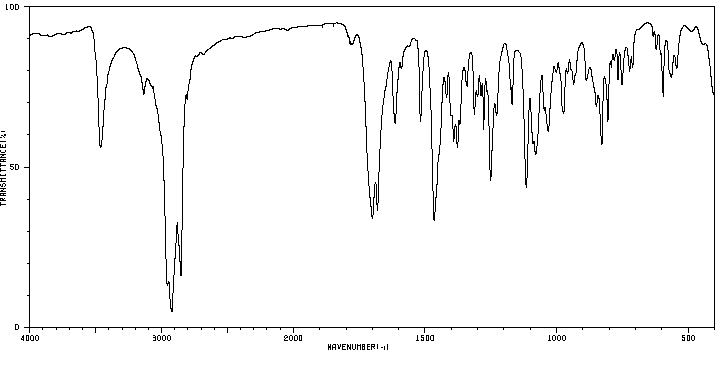2',3'-O-p-Anisyliden-uridin | 53166-52-2
中文名称
——
中文别名
——
英文名称
2',3'-O-p-Anisyliden-uridin
英文别名
1-[(3aR,4R,6R,6aR)-6-(hydroxymethyl)-2-(4-methoxyphenyl)-3a,4,6,6a-tetrahydrofuro[3,4-d][1,3]dioxol-4-yl]pyrimidine-2,4-dione
CAS
53166-52-2
化学式
C17H18N2O7
mdl
——
分子量
362.339
InChiKey
SSPORNDSMRIMHB-ALTVCHKUSA-N
BEILSTEIN
——
EINECS
——
-
物化性质
-
计算性质
-
ADMET
-
安全信息
-
SDS
-
制备方法与用途
-
上下游信息
-
文献信息
-
表征谱图
-
同类化合物
-
相关功能分类
-
相关结构分类
计算性质
-
辛醇/水分配系数(LogP):-0.4
-
重原子数:26
-
可旋转键数:4
-
环数:4.0
-
sp3杂化的碳原子比例:0.41
-
拓扑面积:107
-
氢给体数:2
-
氢受体数:7
上下游信息
反应信息
-
作为反应物:描述:2',3'-O-p-Anisyliden-uridin 在 吡啶 、 L-蛋氨酸 、 recombinant L-methionine : uridine-5'-aldehyde aminotransferase, wild-type 、 磷酸吡哆醛 、 水 、 二甲基亚砜 、 N,N'-二环己基碳二亚胺 、 三氟乙酸 作用下, 反应 36.0h, 生成 5'-amino-5'-deoxyuridine参考文献:名称:Biosynthetic Origin and Mechanism of Formation of the Aminoribosyl Moiety of Peptidyl Nucleoside Antibiotics摘要:Several peptidyl nucleoside antibiotics that inhibit bacterial translocase I involved in peptidoglycan cell wall biosynthesis contain an aminoribosyl moiety, an unusual sugar appendage in natural products. We present here the delineation of the biosynthetic pathway for this moiety upon in vitro characterization of four enzymes (LipM-P) that are functionally assigned as (i) LipO, an L-methionine:uridine-5'-aldehyde aminotransferase; (ii) LipP, a 5'-amino-5'-deoxyuridine phosphorylase; LipM, a UTP:5-amino-5-deoxy-alpha-D-ribose-1-phosphate uridylyltransferase; and (iv) LipN, a 5-amino-5-deoxyribosyltransferase. The cumulative results reveal a unique ribosylation pathway that is highlighted by, among other features, uridine-5'-monophosphate as the source of the sugar, a phosphorylase strategy to generate a sugar-1-phosphate, and a primary amine-requiring nucleotidylyltransferase that generates the NDP-sugar donor.DOI:10.1021/ja206304k
-
作为产物:参考文献:名称:Selective Nucleoside Triphosphate Diphosphohydrolase-2 (NTPDase2) Inhibitors: Nucleotide Mimetics Derived from Uridine-5′-carboxamide摘要:Ecto-nucleoside triphosphate diphosphohydrolases (E-NTPDases, subtypes 1, 2, 3, 8 of NTPDases) dephosphorylate nucleoside tri- and diphosphates to the corresponding di- and monophosphates. In the present study we synthesized adenine and uracil nucleotide mimetics, in which the phosphate residues were replaced by phosphonic acid esters attached to the nucleoside at the 5'-position by amide linkers. Among the synthesized uridine derivatives, we identified the first potent and selective inhibitors of human NTP`Dase2. The most potent compound was 19a (PSB-6426), which was a competitive inhibitor of NTPDase2 exhibiting a Ki value of 8.2,uM and selectivity versus other NTPDases. It was inactive toward uracil nuc leotide- activated P2Y2, P2Y4, and P2Y6 receptor subtypes. Compound 19a was chemically and metabolically highly stable. In contrast to the few known (unselective) NTPDase inhibitors, 19a is an uncharged molecule and may be perorally bioavailable. NTPDase2 inhibitors have potential as novel cardioprotective drugs for the treatment of stroke and for cancer therapy.DOI:10.1021/jm800175e
文献信息
-
Characterization of LipL as a Non-heme, Fe(II)-dependent α-Ketoglutarate:UMP Dioxygenase That Generates Uridine-5′-aldehyde during A-90289 Biosynthesis作者:Zhaoyong Yang、Xiuling Chi、Masanori Funabashi、Satoshi Baba、Koichi Nonaka、Pallab Pahari、Jason Unrine、Jesse M. Jacobsen、Gregory I. Elliott、Jürgen Rohr、Steven G. Van LanenDOI:10.1074/jbc.m110.203562日期:2011.3We now provide in vitro data to support the functional assignment of LipL, the putative TauD enzyme from the A-90289 gene cluster, as a non-heme, Fe(II)-dependent alpha-KG:UMP dioxygenase that produces uridine-5'-aldehyde to initiate the biosynthesis of the modified uridine component of A-90289. The activity of LipL is shown to be dependent on Fe(II), alpha-KG, and O(2), stimulated by ascorbic acid,Fe(II)- 和 α-酮戊二酸 (α-KG) 依赖性双加氧酶是一个庞大且多样化的单核非血红素酶超家族,可进行各种氧化转化,通常将 α-KG 的氧化脱羧与素数的羟基化结合起来基质。含有修饰尿苷成分的几种核苷抗生素的生物合成基因簇,包括来自 Streptomyces sp. 的脂肽基核苷 A-90289。最近报道了 SANK 60405,它揭示了一个共享的开放阅读框,其序列与注释为 α-KG:牛磺酸双加氧酶 (TauD) 的蛋白质相似,这是该双加氧酶超家族的一个特征明确的成员。我们现在提供体外数据来支持 LipL(来自 A-90289 基因簇的推定 TauD 酶)作为非血红素的功能分配,Fe(II) 依赖性 α-KG:UMP 双加氧酶,可产生尿苷-5'-醛以启动 A-90289 的修饰尿苷成分的生物合成。LipL 的活性被证明依赖于 Fe(II)、α-KG 和 O(2),受抗坏血酸刺激,并被几种二价金属抑制。在没有主要底物
-
New nucleoside heteroanalogues: Desoxynucleoside selenocyanates作者:Anatoly M. Belostotskii、Jael Lexner、Alfred HassnerDOI:10.1016/s0040-4039(98)02559-3日期:1999.2Naw nucleoside heteroanalogues, 5'- and 9'-desoxynucleoside selenocyanates and primary desoxysugar selenocyanates, were synthesized from activated nucleoside and sugar derivatives and a new convenient seleno nucleophile, tetrabutylammonium selenocyanate. Tresylate-based activation of hydroxy functions turned out to be most successful for formation of these selenocyanates compared with mesylate- or triflate-based activation. (C) 1999 Elsevier Science Ltd. All rights reserved.
-
4'-Substituted nucleosides. 5. Hydroxymethylation of nucleoside 5'-aldehydes作者:Gordon H. Jones、Masao Taniguchi、Derek Tegg、John G. MoffattDOI:10.1021/jo01322a025日期:1979.4
表征谱图
-
氢谱1HNMR
-
质谱MS
-
碳谱13CNMR
-
红外IR
-
拉曼Raman
-
峰位数据
-
峰位匹配
-
表征信息
同类化合物
(R)-3-(叔丁基)-4-(2,6-二异丙氧基苯基)-2,3-二氢苯并[d][1,3]氧杂磷杂环戊烯
(2S,3R)-3-(叔丁基)-2-(二叔丁基膦基)-4-甲氧基-2,3-二氢苯并[d][1,3]氧杂磷杂戊环
(2S,2''S,3S,3''S)-3,3''-二叔丁基-4,4''-二甲氧基-2,2'',3,3''-四氢-2,2''-联苯并[d][1,3]氧杂磷杂戊环
(2R,2''R,3R,3''R)-3,3''-二叔丁基-4,4''-二甲氧基-2,2'',3,3''-四氢-2,2''-联苯并[d][1,3]氧杂磷杂戊环
(2-氟-3-异丙氧基苯基)三氟硼酸钾
(+)-6,6'-{[(1R,3R)-1,3-二甲基-1,3基]双(氧)}双[4,8-双(叔丁基)-2,10-二甲氧基-丙二醇
麦角甾烷-6-酮,2,3,22,23-四羟基-,(2a,3a,5a,22S,23S)-
鲁前列醇
顺式6-(对甲氧基苯基)-5-己烯酸
顺式-铂戊脒碘化物
顺式-四氢-2-苯氧基-N,N,N-三甲基-2H-吡喃-3-铵碘化物
顺式-4-甲氧基苯基1-丙烯基醚
顺式-2,4,5-三甲氧基-1-丙烯基苯
顺式-1,3-二甲基-4-苯基-2-氮杂环丁酮
非那西丁杂质7
非那西丁杂质3
非那西丁杂质22
非那西丁杂质18
非那卡因
非布司他杂质37
非布司他杂质30
非布丙醇
雷诺嗪
阿达洛尔
阿达洛尔
阿莫噁酮
阿莫兰特
阿维西利
阿索卡诺
阿米维林
阿立酮
阿曲汀中间体3
阿普洛尔
阿普斯特杂质67
阿普斯特中间体
阿普斯特中间体
阿托西汀EP杂质A
阿托莫西汀杂质24
阿托莫西汀杂质10
阿托莫西汀EP杂质C
阿尼扎芬
阿利克仑中间体3
间苯胺氢氟乙酰氯
间苯二酚二缩水甘油醚
间苯二酚二异丙醇醚
间苯二酚二(2-羟乙基)醚
间苄氧基苯乙醇
间甲苯氧基乙酸肼
间甲苯氧基乙腈
间甲苯异氰酸酯








